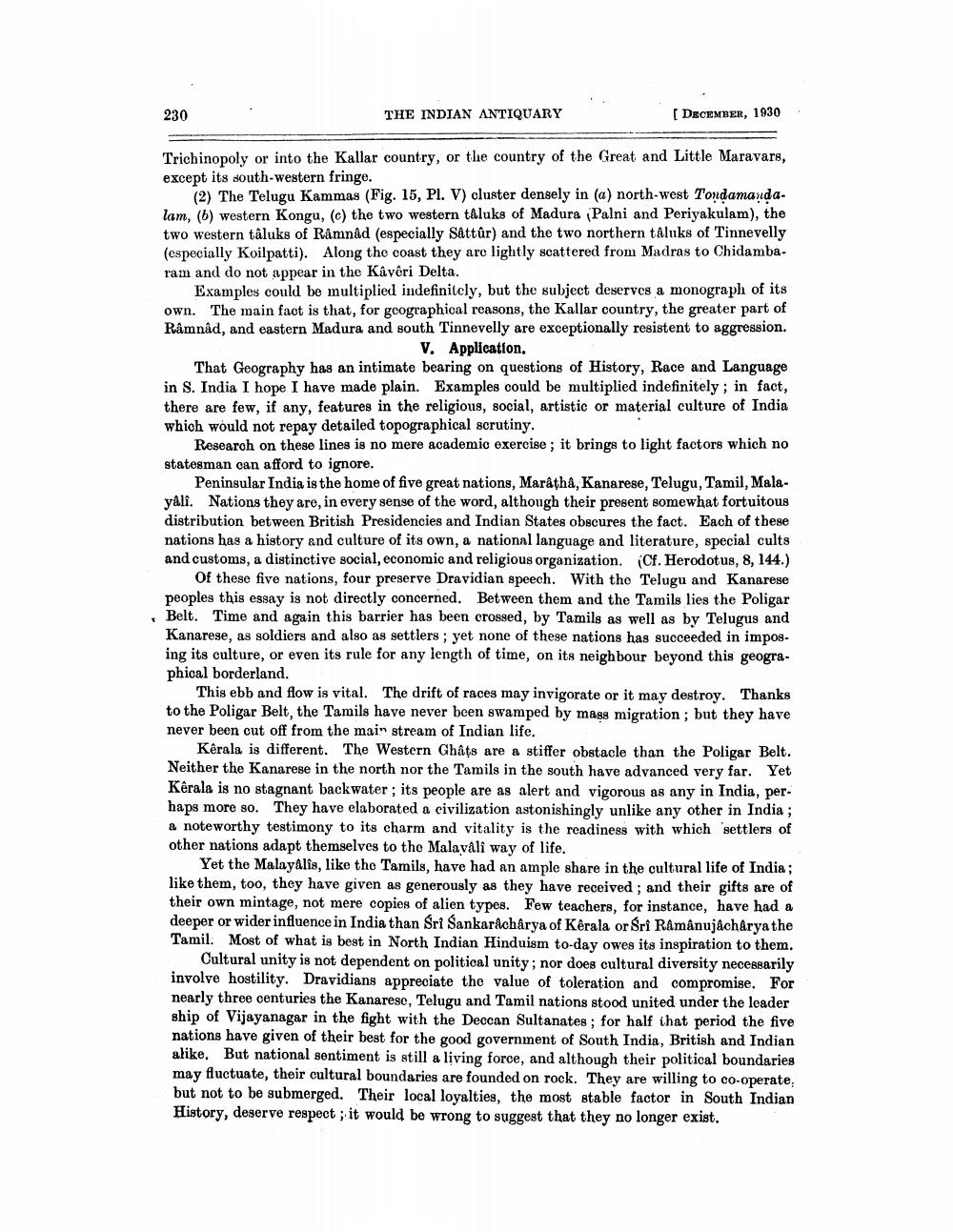________________
230
THE INDIAN ANTIQUARY
[ DECEMBER, 1930
Trichinopoly or into the Kallar country, or the country of the Great and Little Maravars, except its south-western fringe.
(2) The Telugu Kammas (Fig. 15, Pl. V) cluster densely in (a) north-west Tondamandalam, (b) western Kongu, (c) the two western taluks of Madura (Palni and Periyakulam), the two western tâluks of Râmnad (especially Sattûr) and the two northern tAluks of Tinnevelly (especially Koilpatti). Along the coast they are lightly scattered from Madras to Chidambaram and do not appear in the Kavori Delta.
Examples could be multiplied indefinitely, but the subject deserves a monograph of its own. The main fact is that, for geographical reasons, the Kallar country, the greater part of Râmnâd, and eastern Madura and south Tinnevelly are exceptionally resistent to aggression.
V. Application. That Geography has an intimate bearing on questions of History, Race and Language in S. India I hope I have made plain. Examples could be multiplied indefinitely; in fact, there are few, if any, features in the religious, social, artistic or material culture of India which would not repay detailed topographical scrutiny.
Research on these lines is no mere academic exercise ; it brings to light factors which no statesman can afford to ignore.
Peninsular India is the home of five great nations, Maratha, Kanarese, Telugu, Tamil, Malayali. Nations they are, in every sense of the word, although their present somewhat fortuitous distribution between British Presidencies and Indian States obscures the fact. Each of these nations has a history and culture of its own, a national language and literature, special cults and customs, a distinctive social, economic and religious organization. (Cf. Herodotus, 8, 144.)
Of these five nations, four preserve Dravidian speech. With the Telugu and Kanarese peoples this essay is not directly concerned. Between them and the Tamils lies the Poligar Belt. Time and again this barrier has been crossed, by Tamils as well as by Telugus and Kanarese, as soldiers and also as settlers; yet none of these nations has succeeded in imposing its culture, or even its rule for any length of time, on its neighbour beyond this geographical borderland.
This ebb and flow is vital. The drift of races may invigorate or it may destroy. Thanks to the Poligar Belt, the Tamils have never been swamped by mags migration ; but they have never been cut off from the main stream of Indian life.
Kerala is different. The Western Ghats are a stiffer obstacle than the Poligar Belt. Neither the Kanarese in the north nor the Tamils in the south have advanced very far. Yet Kerala is no stagnant backwater; its people are as alert and vigorous as any in India, perhaps more so. They have elaborated a civilization astonishingly unlike any other in India; a noteworthy testimony to its charm and vitality is the readiness with which settlers of other nations adapt themselves to the Malayali way of life.
Yet the Malayalis, like the Tamils, have had an ample share in the cultural life of India; like them, too, they have given as generously as they have received ; and their gifts are of their own mintage, not mere copies of alien types. Few teachers, for instance, have had a deeper or wider influence in India than Sri Sankaracharya of Kerala or Sri Ramanujacharya the Tamil. Most of what is best in North Indian Hinduism to-day owes its inspiration to them.
Cultural unity is not dependent on political unity; nor does cultural diversity necessarily involve hostility. Dravidians appreciate the value of toleration and compromise. For nearly three centuries the Kanaresc, Telugu and Tamil nations stood united under the leader ship of Vijayanagar in the fight with the Deccan Sultanates; for half that period the five nations have given of their best for the good government of South India, British and Indian alike. But national sentiment is still a living force, and although their political boundaries may fluctuate, their cultural boundaries are founded on rock. They are willing to co-operate, but not to be submerged. Their local loyalties, the most stable factor in South Indian History, deserve respect; it would be wrong to suggest that they no longer exist,




